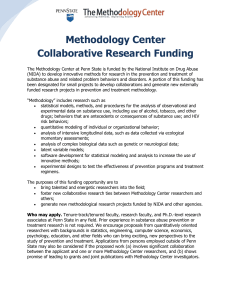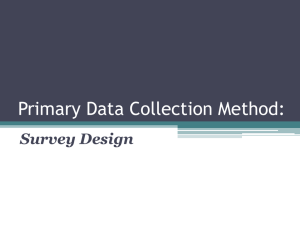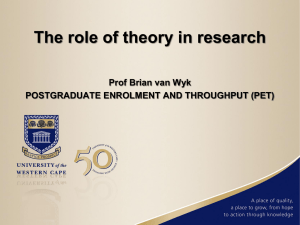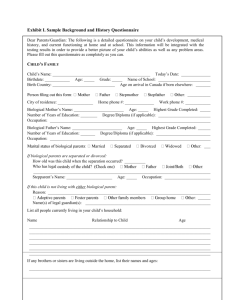Action Research Plan (M.A.T.H.S.) - Amber Ernst
advertisement
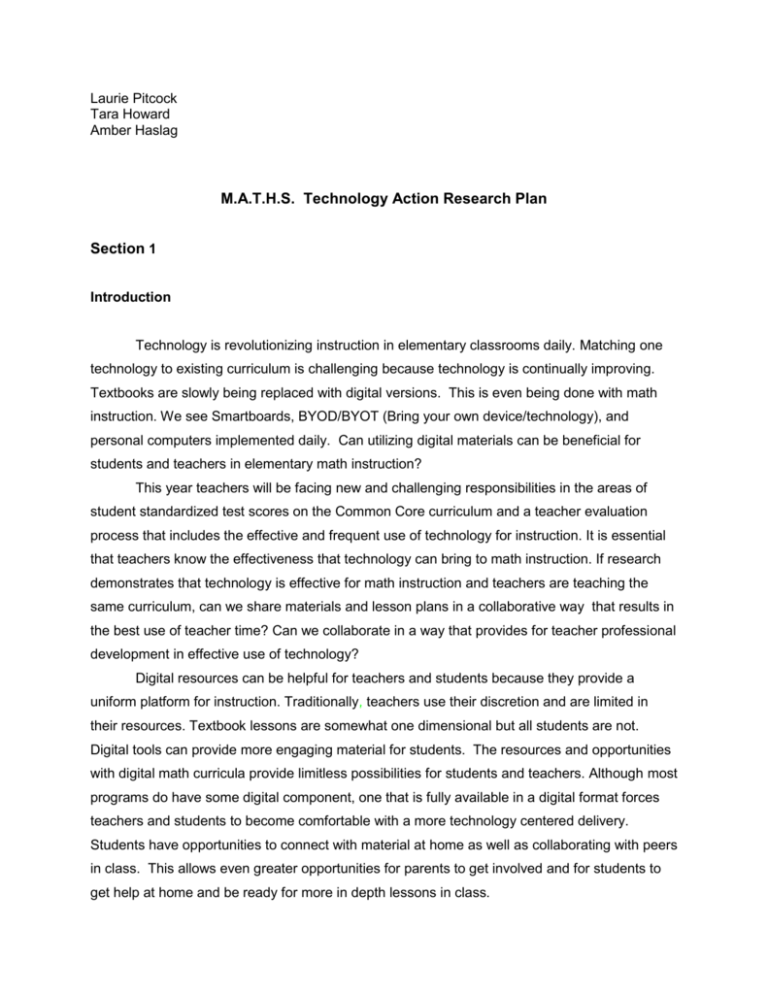
Laurie Pitcock Tara Howard Amber Haslag M.A.T.H.S. Technology Action Research Plan Section 1 Introduction Technology is revolutionizing instruction in elementary classrooms daily. Matching one technology to existing curriculum is challenging because technology is continually improving. Textbooks are slowly being replaced with digital versions. This is even being done with math instruction. We see Smartboards, BYOD/BYOT (Bring your own device/technology), and personal computers implemented daily. Can utilizing digital materials can be beneficial for students and teachers in elementary math instruction? This year teachers will be facing new and challenging responsibilities in the areas of student standardized test scores on the Common Core curriculum and a teacher evaluation process that includes the effective and frequent use of technology for instruction. It is essential that teachers know the effectiveness that technology can bring to math instruction. If research demonstrates that technology is effective for math instruction and teachers are teaching the same curriculum, can we share materials and lesson plans in a collaborative way that results in the best use of teacher time? Can we collaborate in a way that provides for teacher professional development in effective use of technology? Digital resources can be helpful for teachers and students because they provide a uniform platform for instruction. Traditionally, teachers use their discretion and are limited in their resources. Textbook lessons are somewhat one dimensional but all students are not. Digital tools can provide more engaging material for students. The resources and opportunities with digital math curricula provide limitless possibilities for students and teachers. Although most programs do have some digital component, one that is fully available in a digital format forces teachers and students to become comfortable with a more technology centered delivery. Students have opportunities to connect with material at home as well as collaborating with peers in class. This allows even greater opportunities for parents to get involved and for students to get help at home and be ready for more in depth lessons in class. Assessment and data monitoring are also advantages of digital curriculum (Reily, 2004). With clear goals and expectations for students, teachers can easily monitor student performance and differentiate instruction, giving more time where students need help. As technology plays an increasingly more important part of our day to day lives, utilizing a digital program not only addresses students current needs but prepares them for their future. Even though technology is not without its flaws and issues, experience can provide us with ways to solve these problems. Great technical support can remedy issues and give support to teachers implementing curriculum. Learning with technology shows students how to be lifelong learners in this digital age. Research has shown and teachers know well that there is a wide spectrum of math ability levels in each classroom (O’Malley et al., 2013). How can a teacher address each different level without frustrating students or wasting student learning time? Technology provides opportunities for teachers to address differing student ability level in small group instruction or through 1:1 computing. Math is a preferred subject to begin utilizing a primarily technology driven program. While reading is important to understanding math it is not the most vital skill. Math works well because skills can be improved regardless of reading levels. Because math is not tied directly to reading, especially in the primary grades, students who struggle with reading can feel successful in math. Using technology to set and achieve goals in Math will motivate students as well as improve a students’ self efficacy. The website IXL.com will be the focus of our study. We chose this site for the appeal to students, cost, and ease of tracking and reporting data. Area of Focus Statement The purpose of this study is to determine if digital math curriculum or digital tools will improve math performance. Many students view math as difficult and assign a negative connotation to it. Incorporating technology into math curriculum can provide a way to engage students and connect math to their lives. Digital math resources can be beneficial to students by differentiating learning paths. A district’s curriculum is uniform in the sense that every teacher receives the same materials but technology could ease the implementation or add valuable resources that help learning for all students. In this digital age, students need to be technologically savvy and using digital curriculum and resources gives students experience with technology at an early age. Research Question How can digital resources improve performance over traditional whole group instruction using textbooks, specifically in math? Will effective technology use result in an increase of student achievement in math for elementary aged students? Related Literature Medicino, Razzaq and Hefferman (2009) studied the difference between Web-based and traditional paper and pencil homework. They found a significant increase in students that completed and understood their homework using web-based homework. The Web-based homework was done on an ASSIST system that acted like a tutor for the students. Having the digital component of the math curriculum can keep students engaged at their level for mathematics even at home therefore promoting a lifelong learning of math. Reily (2004) compared different digital math curricula. The author connected the benefits of three programs ProProgress Math, PLATO Math, and CompassLearning Odyssey Math-for districts going through the process of purchasing or how they could help the students. A huge component of those programs was their focus on data and assessment. Individualized data can help teachers track individual students and where they might need help or need to be pushed. Foughty and Keller(2011) reported how teachers in Indiana changed their math instruction by participating in a program that replaced textbooks with digital curricula. Teachers there found that students had the chance to learn at their own pace allowing some students to learn more than one year’s worth of curriculum in a few months. Teachers felt that the digital curricula allowed them to shift time away from grading papers to monitoring student data. Indiana allowed schools to make the decision how to implement the curricula. This gave schools and teachers the flexibility to meet individual students needs in the way that best suited their students. Lan, Sung, Tan, Lin, & Chang(2010) conducted research on the effectiveness of portable digital devices for instruction of computational estimation through problem based learning with elementary school students. Each student in the experimental group was given a TravelMate C110 Convertible Tablet PC and used Group Scribbles (GS), developed by SRI international (SRI International, 2007). The students in both the experimental and control groups received identical instructional scenarios, were encouraged to collaborate and given very similar visual aids. The difference came in that the experimental group collaborated with their group using a tablet PC and the control group collaborated through being physically grouped together. The researchers discovered that in the control group, students with better ability dominated the collaborative process while the other students in the group almost always listened to and agreed with the higher performing students. This was also borne out in test results that showed students in the control group achieved metacognitive learning at lower levels. The students in the experimental group of “this study found that significantly more students in the experimental group than the control group could choose appropriate strategies for solving real world problems.” (Lan, Sung, Tan, Lin, & Chang, 2010). O’Malley, Jenkins, Wesly, Donehower, Rabuck, and Lewis (2013) researched if using the Racer App for iPad would result in improvement in accuracy and speed with which a student can solve simple computations. The data sample included ten students with moderate to severe cognitive disabilities. The researchers recorded the time it took students to complete twenty basic addition and subtraction problems and the number correct. There were three findings from this research. They found that the iPad App was highly engaging for students and teachers had a very positive response to their use with their students. The effect of this App on increased basic math fluency was mixed. It helped some students make significant gains and with other students showed it was not effective. The third finding was qualitative data concerning the integration of technology with learning. Intervention For this action research plan, we will collect data from a control group of 20-25 3rd grade students and an experimental group of 20-25 3rd grade students. The students will be in the same school and grade level with different teachers. The control group of students will receive instruction on a lesson over multiplication/division in math. The control group will use traditional paper and pencil methods along with whole group instruction from a teacher to complete the lesson. The experimental group will experience the same lesson but use digital tools specifically the website IXL.com to work through problems. This gives the opportunity to do research in a normal classroom setting. Although there would be two different teachers in the classrooms, the lessons will be the over the same material with different delivery. Scores on the short pre and post test will provide data to see if the digital tool made a difference. Section II Data Collection Strategies Overview Our research utilizes various data collection strategies. Observation of teachers will give researchers an idea of the two classrooms and to ensure that research will be conducted according to the research plan. A student questionnaire will give the researchers a student perspective of technology in their math class. The teacher questionnaire will show to what extent technology is used currently and what teachers might like to do with technology more in math. The last data collection strategy will be data collected from the pre and post tests given to the students before the implementation of technology to help practice facts of multiplication and division. Our research plan will be valid because the intervention group and comparison group are the same ages, at the same school, and will have been taught the same lesson. The teachers will both follow as closely as possible to the lesson plan ensuring students receive the same material. The pre and post tests that will be given to both classes will be the exact same in time for completion, number of questions, and wording of questions. The preciseness of the tests will give the researchers a good indication if digital tools can improve achievement in math. The results will be reliable because the experiment could easily be repeated with another set of classes. We have controlled all variables to keep classes as close to same as possible. Quantitative data will be gathered from the pre and post test scores of both classes. This data will be analyzed to see if digital tools played a role in achievement. Qualitative data will be gathered from observation and questionnaires completed by the students and teachers. This will help inform the researchers of the current environment in the classroom and school. It will also give a clearer picture of the classroom especially with the view the students and teachers hold about technology and how it plays a part in their classroom and their learning. The student participants will remain anonymous in our study and their names will be kept confidential. We will ask for informed consent from the teacher participants to release their names only to other teachers in our school in order that future questions may be directed specifically to them for the purpose of improved teacher instruction. We will review and follow local school district protocol. Administration will be briefed before starting the research. Their approval will indicate the beginning of the research. Parent approval will not be needed because it is implementing curriculum in different ways but not changing the content in any way that will affect the students. Data Sources The student questionnaire would be given to the students first. This questionnaire seeks information about student attitudes toward math in general and using computers to learn math. It asks if they think computers help them to improve their math skills and how often their teacher use technology to teach math. The teacher questionnaire would be given to the teachers by the researchers when they are available to meet prior to the math lesson. The pre tests will be given to both classes then the teachers will teach the math lesson. The intervention group will receive instruction along with ten minutes of individual practice daily using IXL.com on a computer. The comparison group will receive instruction along with ten minutes of practice daily using conventional, non digital resources. The After two weeks of instruction of multiplication and division, the teachers will give the short timed post test to both classes. The teachers will give the post test on the same day. The tests will be graded and reviewed by the researchers who will use the answers as data to compare the classes. Researchers will observe throughout the lessons to ensure that the teachers are following all specific instructions and both lessons are being taught the same way. During the observation, researchers will count the number of minutes the classroom teacher uses technology and determine the percentage of students that are engaged while using technology. Even with only two classes, the exact comparison should be enough to see if technology played an impact in the learning of students in an elementary math classroom. Data Analysis Plans The teacher questionnaire will provide information about how the teachers use technology for math skills in elementary classrooms. Researchers will calculate the mean average of minutes teachers report using technology per week. Teachers will also respond with exactly what type of technology they use for math. Researchers will figure the totals of the types of hardware and software used by the teachers. The remaining answers will give researchers a clearer picture of how the technology is used in math instruction specifically fact fluency. Researchers will calculate the number of yes/no answers to these remaining questions. The specific answers will lead researchers to know exactly how much time is spent with technology and how technology is being used. The answers will show how the school responds to technology and how it is incorporated in math either by curriculum itself, math facts, or teacher use. The questionnaire answers will show how aware teachers are of the use of technology and in ways they do or do not incorporate technology into their math instruction daily. The most important data will be collected from the pre and post test scores from the classes. They will be analyzed to see if digital tools can improve math skills. The researchers will calculate four mean averages for two classes and two tests (pre and post). The student questionnaire will be short but include student perspective on technology in their math class. The observation of students will be completed in the weeks prior to the actual conducting of the research. Students will be researched in their own classrooms during their normal math time. Researchers will be specifically looking for the use of digital tools when students are practicing their math skills. Researchers will collect data in the form of anecdotal notes. The notes will be collected, along with data from other sources such as instructional coaches or administrators in the building, to get a clear picture of technology use in math in an elementary classroom. Section III Will there be other people involved in your action research project? If so, who are they and what would be their responsibilities? Our project will include two participating third grade classroom teachers. These teachers will need to be available to meet before, during and after the intervention in order to prepare to implement critical portions of the project. We will need two groups of twenty to twenty-five students in two separate third grade classes. The groups of students will be in the classes of the two participating teachers. We will interview and communicate with the instructional coach and administrators at the school. They will provide anecdotal evidence to the researchers pertaining to the use of technology to teach math in third grade classrooms at this school. The administrators will be responsible for giving the final approval for us to conduct this research project. What negotiations would you need to undertake prior to beginning your project? For example, would you need to secure an administrator's permission? Parents' permissions? In order to conduct ethical research we will review and follow district protocol. We will meet with the principal, third grade level assistant principal, and the instructional coach. The purpose of this meeting is to discuss the Teacher Action Research Plan, obtain permission, and finalize the implementation timeline. Parent permission is not needed since student participants will remain anonymous and their names, scores, and any related notes will be kept confidential. The students will receive instruction on the same curriculum so there are no concerns about a negative impact on their learning. We will ask for informed consent from the two participating teachers since their names will be released to other teachers in the school. This allows an opportunity for follow-up questions within the building. What is the projected timeline for collecting, analyzing, and interpreting data? Data collection and analyzation will be done on a timeline established by the teachers and approved by administration before starting the project. It will coincide with content so the teachers do not have modify or change timing of any lessons.The week prior to intervention, researchers will meet with administrators and teachers to gather data and share information. Researchers will start to collect qualitative data by implementing the teacher questionnaire and the student questionnaire before the start of the intervention. Researchers will meet with the instructional coach and administrators to collect information about the use of technology to teach math in third grade classrooms. The intervention phase of the research project will take two weeks. Pre test data will be collected shortly before the intervention begins. During the intervention phase, observational data will be collected by researchers in participating classrooms. At the end of two weeks, the teachers will give the post test to students. The researchers will analyze and interpret the quantitative and qualitative data soon after it is compiled. The grading and averaging of the scores will occur within two weeks of the first lesson. The scores will be shared with the teachers and administration during the analyzation process. The whole process will take 4 weeks. What is the projected timeline for developing your recommended actions? Researchers will organize and analyze the quantitative and qualitative data in the first week after the post test. The second week will be used to develop recommendations, an action plan to implement the recommendations and suggestions for sharing data results. Results will be shared with all involved individuals at the school that want to know the pertinent information. This should be done within two weeks of finishing the post tests so that accurate and reliable information will be provided to the school. What would be your overall strategy for implementing any recommended actions resulting from your project (e.g. , who would need to be involved in the implementation process? what support might you need? what factors in your school culture might inhibit or support any innovation or intervention actions?) Researchers will form a committee made up of administrators and the technology department to determine which strategies would be the most easily implemented immediately. The committee would also prioritize the recommendations into a timeline for implementation as well as those suggestions that are not possible at the time. Teachers will also be given the opportunity to provide their input about the recommendations and the timeline. The attitude and openness of the teachers will have a great impact on the implementation of recommendations. Other factors that may present a challenge is the availability of hardware at the time of implementation. What would be your process for ongoing monitoring (data collection and interpretation) of recommended actions? School systems expect professional goal setting. Integrating technology with math instruction will be a goal required for all teachers that will be reviewed at the end of the year. Administrators could also require students to use the recommendations and test or provide data in terms of overall growth. Teachers will guide students to set goals and track (graph) their own progress. Teachers will monitor student progress and information could be relayed to parents at conference and report card time. Teachers will analyze the data to make sure all types of learners are progressing and to make adjustments as needed to ensure student success. References Foughty, Z & Keller, J. (2011). Implementing Digital Math Curricula. Principal Leadership, 64-66. Lan, Y., Sung, Y., Tan, N., Lin, C., & Chang, K. (2010). Mobile-Device-Supported ProblemBased Computational Estimation Instruction for Elementary School Students. Journal Of Educational Technology & Society, 13(3), 55-69. Mendicino, M., Razzaq, L., & Heffernan, N. T. (2009). A Comparison of Traditional Homework to Computer-Supported Homework.Journal Of Research On Technology In Education, 41(3), 331-359. O'Malley, P., Jenkins, S., Wesley, B., Donehower, C., Rabuck, D., & Lewis, M. B. (2013). Effectiveness of Using iPads to Build Math Fluency. Reilly, R. (2004). Technology-Based Mathematics: Tools and Content for Teaching, Assessment, and Accountability. Multimedia & Internet@Schools, 11(5), 30-35. Shih, S.-C., Kuo, B.-C., & Liu, Y.-L. (2012). Adaptively Ubiquitous Learning in Campus Math Path. Educational Technology & Society, 15 (2), 298–308. Appendix A: Literature Matrix Author Year Variables in Study K-8 Grade Level Specific Programs Foughty, Zach & Keller, John 2011 x x Shih, S.-C., Kuo, B.C., & Liu, Y.-L. 2012 x x Reilly, R 2004 x x Lan, Y., Sung, Y., Tan, N., Lin, C., & Chang, K. 2010 Mendicino, M., Razzaq, L., & Heffernan, N. T. 2009 O'Malley, P., Jenkins, S., Wesley, B., Donehower, C., Rabuck, D., & Lewis, M. B. x x 2013 Achievement results Digital Assessment and Data x x x x x x x x Appendix B: Data Matrix Research Question Data Source Do teachers use technology for math? Teacher questionnaire Student questionnaire Observation How often is technology used to help with math skills/instruction? Teacher questionnaire Student questionnaire Observation Do classrooms have access to technology for math programs? Teacher questionnaire Student questionnaire Observation Does technology improve math scores along with motivating and engaging students? Data from program Student questionnaire Observation Appendix C: Data Analysis Matrix Data Collection Technique Data Analysis Strategy Teacher Questionnaire (Appendix D) Calculate the mean average of minutes answered in Question 3 Figure totals for various answers in questions 1 and 2 Calculate number of yes/no answers for remaining answers Student questionnaire Calculate the mean of Question 1 to determine motivation to learn subject Calculate the means of Question 2 and 3 to determine efficacy without technology Calculate the mean of Question 5 to determine the efficacy with technology Observation Calculate number of minutes technology is used during math instruction Calculate percent of students engaged when technology is present Calculate the availability of technology to students Data from pre/post test Calculate the mean average of the raw scores for T3A, T3B, Nt3A, and Nt3b. Calculate the difference between T3A and Nt3A; same for post tests. Calculate the difference between T3A and T3B; calculate the difference between Nt3A and Nt3B. Symbols used to denote mean average of raw score Pre-test Post-test Class that used technology T3A T3B Class that did not use technology Nt3A Nt3B Appendix D: Teacher Questionnaire Questionnaire (as it appears on Survey Monkey) 1. What kind of technology do you (as the teacher) use to enhance your math instruction (indicate all that apply) Internet based program (free) Internet based program (subscription) Downloaded/Installed Program Computers Tablets Student Response Systems SMART Board SMART Notebook/Flip Pages/ Promethean type program I don’t use technology to enhance my instruction. Other (please specify) 2. What kind of technology do you students use to practice math skills(indicate all that apply) Internet based program (free) Downloaded/Installed Program Tablets Fact Recall Other (please specify) Internet based program (subscription) Computers Student Response Systems Concept Application 3a. How many days per week do the students use technology to extend or review math skills? 0 days 1 day 2 days 3 days 4 days 5 days 3b. About how many minutes per session (on average) do students use technology for math? 0-10 minutes 11-20 minutes 21-30 minutes 31-40 minutes 41-50 minutes 51-60 minutes more than 60 minutes per session 4. Do you have computers students may use to access specific websites? Yes No 5. Does your math text have an online component available for student use? Do you use it? I Use I Don’t Use Available Not Available I’m Not Sure What is the name of your current math curriculum (please include the name of the program and the publisher if applicable- for example: Scott Foresman Invision): ____________________________________________________________________________ __ 6. Would you be more likely to monitor student data on a computer system that logged information rather than grading tests everyday? Would this make tracking data easier? Yes No Yes No 7. To the best of your knowledge, does your school have a budget for technology for software (programs, subscriptions) and/or hardware? Yes No 7b. If yes, how much of the budget is allocated for math materials only? less than 50% more than 50% not sure




